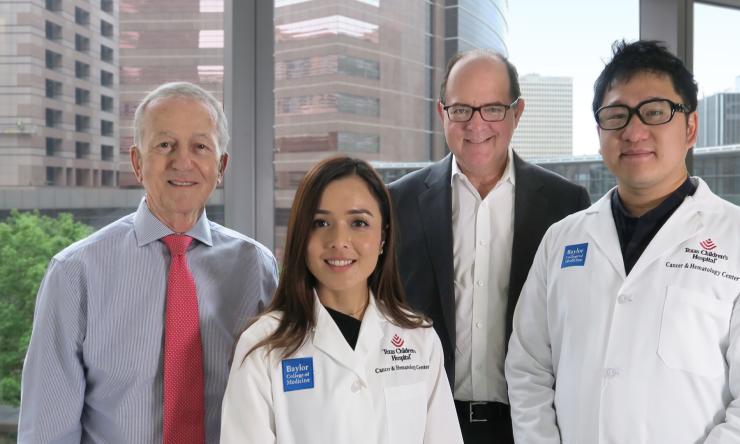Mutated blood cells define clinical risks in Langerhans cell histiocytosis
A nationwide team led by researchers at ≤ð¡Ò…Á«¯»Îø⁄, Texas Children‚Äôs Hospital and UPMC Children's Hospital of Pittsburgh has proposed a major revision to how Langerhans cell histiocytosis (LCH) is diagnosed and treated after analyzing patients with LCH for several years.
“The proposed revisions are the culmination of more than a decade of work and would not have been possible without collaboration in clinical trials and translational research between scientists, patients and families. The findings from this study identify genetic changes in a type of precursor blood cell that predict a much higher chance of treatment failure and risk of developing LCH-associated neurodegeneration,” said Dr. Carl Allen, co-corresponding author, co-director of the Pediatric Cancer Program at the Dan L Duncan Comprehensive Cancer Center at Baylor and co-director of the at Texas Children’s Cancer and Hematology Center.
LCH is a rare cancer that is characterized by the abnormal growth of immune cells called Langerhans cells. While these cells normally help regulate the immune system, in individuals with LCH they accumulate and form tumors in one or more organs. Some patients also develop LCH-associated neurodegeneration, which is caused by inflammatory LCH cells that migrate to the brain, eventually leading to problems with certain brain functions, especially related to fine motor movement.
“Contemporary staging approaches were developed at a time when the nature of LCH as a cancer was debated, mutations in tumors had not been discovered and advanced PET-CT imaging scans were not routinely used. Currently, all patients with systemic LCH receive basically the same chemotherapy that ultimately cures fewer than half and has little effect on LCH-associated neurodegeneration,” Allen said.
“Another major finding from our study is that mutated precursor cells hiding in the bone marrow of certain LCH patients can be missed with standard histology and reported as ‘normal.’ When LCH patients undergo bone marrow analysis, molecular studies are required to identify these rare disease cells, which may not be recognized as LCH by traditional staining methods,” said Dr. Jennifer Picarsic, chief and chair of Pediatric Pathology at UPMC Children’s Hospital of Pittsburgh.
The study enrolled 385 children and adolescents with LCH from 2006 to 2023 and followed them for a median of four years. Researchers correlated patient outcomes with the extent of LCH at diagnosis, tumor genotype and presence of the BRAFV600E mutation in blood and bone marrow cells pre-therapy.
The findings, published in the journal , support a major revision for pediatric LCH diagnostic staging that considers the underlying drivers of disease. “In the study, we found that patients who present with a reservoir of precursor disease cells with the most common BRAFV600E mutation in bone marrow and blood are at the highest risk of treatment failure and LCH-associated neurodegeneration,” Allen said.
Myeloid cells, a type of white blood cell, originate in the bone marrow and circulate ‘peripherally’ in the blood; the same is true for mutant myeloid LCH precursors. “These novel mechanistic insights and sensitive molecular testing strategies create possibilities for risk-stratification regimens that can be better tailored to individual patients,” Allen said.
The study highlights how modern imaging and sensitive, updated molecular diagnostics offer an opportunity to improve risk-stratification for pediatric LCH. “This study, which includes a 15-year longitudinal cohort with correlative biology, is unprecedented. It has both an immediate impact and future implications for the care of these patients,” said contributing author Dr. D. Will Parsons, professor of pediatrics at Baylor and interim director of the Texas Children’s Cancer and Hematology Center. “This study builds on long-standing NIH-funded research collaborations with Dr. Miriam Merad and her team at Icahn School of Medicine at Mount Sinai that have investigated causes of LCH to improve therapies and outcomes for patients.”
Authors who contributed to this work include Howard Lin, Akansksha Batajoo, Daniel Zinn, Olive Eckstein, Nader El-Mallawany, Nitya Gulati, Erin Peckham-Gregory, Zachary Prudowsky, Brooks Scull, Jessica Velazquez, Harshal Abhyankar, Stephen Simko, Daria Vakula, Ryan Fleischmann, Vivekanudeep Karri, John Hicks, Kevin Fisher, Choladda Curry, Angshumoy Roy, Deborah Schiff, Kenneth Heym, Michael Scheurer, Tsz-Kwong Man, D. Williams Parsons, Miriam Merad, Kenneth McClain, Jennifer Picarsic and Carl E. Allen.
The authors are affiliated with one or more of the following institutions: ≤ð¡Ò…Á«¯»Îø⁄, Texas Children's Hospital, Lehigh Valley Health Network, Weill Cornell Medical College, University of California San Diego, Cook Children‚Äôs Medical Center, Ichan School of Medicine at Mount Sinai and University of Pittsburgh School of Medicine.
This work is supported by the National Institutes of Health, Department of Defense, St. Baldrick's Foundation, the Leukemia and Lymphoma Society, HistioCure Foundation and the Sauer Family Histiocytosis Program. For the complete list of funding sources see the .



